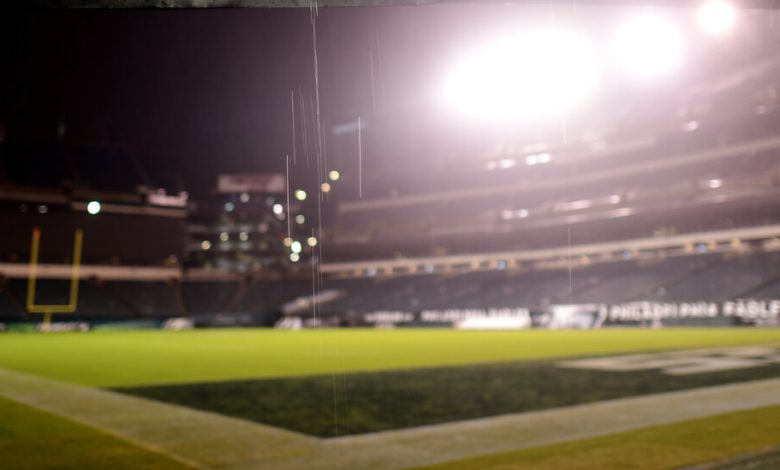Damar Hamlin and the Beautiful Terror of Loving Football

I have been a football fan for practically my entire life. I’ve watched hundreds, maybe thousands, of college and N.F.L. games, and I will watch football this weekend.
My decision to do so is almost less of a decision than a reflex: It is Sunday. I am me. Thus, I am watching football. Not only is it my favorite sport, but I’ve written about and covered the sport as a reporter and as a commentator. I was able to eventually write for The New York Times in part because of the training I got writing about “Monday Night Football” matchups and the vagaries of kick-catch interference penalties. In many ways, football has given me the career I have now, the opportunities I have now, the platform I have now.
I wasn’t watching last Monday’s matchup between the Buffalo Bills and the Cincinnati Bengals, as the stress from the College Football Playoff (and Michigan’s loss to Texas Christian University) had caused me to take a brief vacation from the world of football. But then I got a text from a friend saying that something had happened in that game, the scariest thing he’d ever seen watching football.
That’s when I saw the footage of Buffalo Bills safety Damar Hamlin collapsing to the ground after making a routine tackle and going into cardiac arrest, his teammates crying out in sorrow and fear and the Bills wide receiver Stefon Diggs in tears while Mr. Hamlin received CPR for nine agonizing minutes. (Mr. Diggs later reportedly took an Uber to the hospital to be with his teammate). I’ve seen a lot of football, which means I’ve seen terrible injuries, but on Monday night I thought that perhaps I had just seen someone die on the field for the first time in a professional football game since 1971.
I keep imagining a giant pendulum swinging between the immense gifts and the immense costs of playing football at the highest level. Getting to play in the N.F.L. is a privilege — of the thousands of people who play football in college, just 1.6 percent go on to play professionally. But even playing a single snap in the N.F.L. can carry risks — the average career lasts just three years.
N.F.L. players are some of the best known — and best paid — professional athletes in the country. Even if you haven’t watched a single N.F.L. game, you’ve probably seen Kansas City Chiefs quarterback Patrick Mahomes in a State Farm ad, or you might recognize Aaron Rodgers, quarterback for the Green Bay Packers. But many players suffer financially or even go bankrupt after they retire, their names largely forgotten, just a part of the churn that makes up the most profitable sports league on earth.
Football is, to me, the most beautiful sport in the world. It’s a logic game played at full speed, a chess match, a whirlwind — and sometimes it’s completely, wonderfully bonkers. The people who play it love it, too. When Mr. Hamlin awoke from sedation on Thursday, it was reported that among his first questions (in writing) to doctors was who won the game he’d been playing when he collapsed. But football can, and has, killed the people who play it, including at the high school level every year. The sport I love most is football. The sport that has given me the most is football. But this sport has devastated lives and families. What do I, and other fans of the sport, owe them?
I put this question in an email to Domonique Foxworth, the former N.F.L. cornerback, former N.F.L. Players Association president and ESPN contributor, who has been open and honest in his discussions about Damar Hamlin and how N.F.L. players are perceived by the people who watch the sport. “I don’t know that I have a clean answer for this,” he told me, adding, “They get treated much better than most people when they do something extraordinary and they are dehumanized when they fail.”
He said that the conversation about what football fans owe the people who play the sport was complicated, by race and money and fame and who knows what else. He also noted: “I’m sure a million tragic things happened to people across the country on Monday night and Damar Hamlin is the only person to get the compassionate outpouring. Which I guess makes me feel good.” But, “I also think about how we as fans would react if he had a dumb penalty that cost him the game.” I’ve seen that reaction all too often. And to be honest, I’ve had that reaction myself all too often.
We often treat football players like they are either untouchable gods or useless simpletons who are unable to make a tackle (that we assuredly could not make ourselves). But football players are people, first and foremost. After Damar Hamlin collapsed, his teammates took off their helmets and some knelt close to him while others consoled one another nearby. I saw faces I knew from years of watching the sport, and some faces I didn’t, every face full of terror and concern for their friend, their teammate, their brother.
Some of the fans from the stadium gathered there to pray for Mr. Hamlin, while others went to the hospital to stand outside in a show of support. They did that because on the field that evening, they saw what we all should see when we watch an N.F.L. game: real human beings taking part in a beautiful, brutal sport for our entertainment.
Jane Coaston is an Opinion writer and was the host of “The Argument.”
The Times is committed to publishing a diversity of letters to the editor. We’d like to hear what you think about this or any of our articles. Here are some tips. And here’s our email: [email protected].
Follow The New York Times Opinion section on Facebook, Twitter (@NYTopinion) and Instagram.
